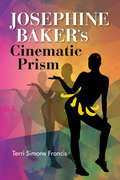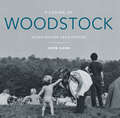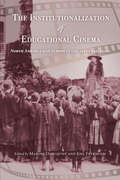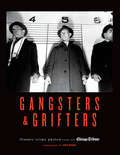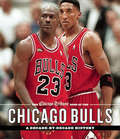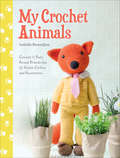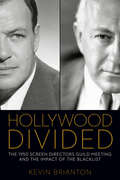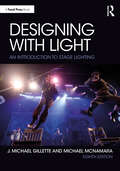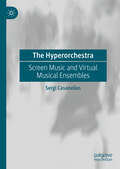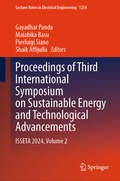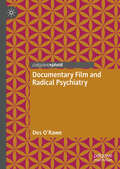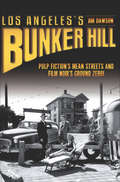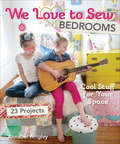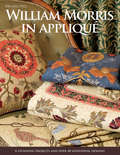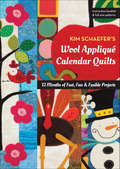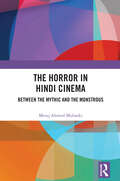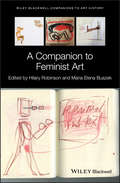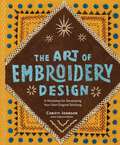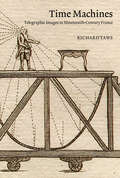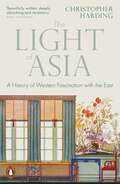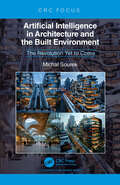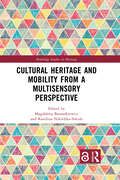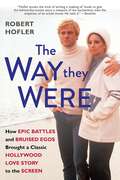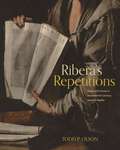- Table View
- List View
Josephine Baker's Cinematic Prism
by Terri Simone FrancisA history and in-depth analysis of the film career of the iconic Black star, activist, and French military intelligence agent. Josephine Baker, the first Black woman to star in a major motion picture, was both liberated and delightfully undignified, playfully vacillating between allure and colonialist stereotyping. Nicknamed the &“Black Venus,&” &“Black Pearl,&” and &“Creole Goddess,&” Baker blended the sensual and the comedic when taking 1920s Europe by storm. Back home in the United States, Baker&’s film career brought hope to the Black press that a new cinema centered on Black glamour would come to fruition. In Josephine Baker&’s Cinematic Prism, Terri Simone Francis examines how Baker fashioned her celebrity through cinematic reflexivity, an authorial strategy in which she placed herself, her persona, and her character into visual dialogue. Francis contends that though Baker was an African American actress who lived and worked in France exclusively with a white film company, white costars, white writers, and white directors, she holds monumental significance for African American cinema as the first truly global Black woman film star. Francis also examines the double-talk between Baker and her characters in Le Pompier de Folies Bergère, La Sirène des Tropiques, Zou Zou, Princesse Tam Tam, and The French Way, whose narratives seem to undermine the very stardom they offered. In doing so, Francis illuminates the most resonant links between emergent African American cinephilia, the diverse opinions of Baker in the popular press, and African Americans&’ broader aspirations for progress toward racial equality. Examining an unexplored aspect of Baker&’s career, Josephine Baker&’s Cinematic Prism deepens the ongoing conversation about race, gender, and performance in the African diaspora.
Pilgrims of Woodstock: Never-Before-Seen Photos
by John KaneIntimate portraits by photojournalist Richard F. Bellak of the musical festival&’s counterculture attendees celebrating peace, love, and rock and roll. In the summer of 1969, 400,000 people from across the country came together and redefined the music scene forever. Though the legacy and lore of Woodstock lives on in the memory of its attendees, a new generation can experience the real and unedited festival through Richard Bellak&’s never-before-seen photographs and John Kane&’s incredible new interviews.Pilgrims of Woodstock offers a vivid and intimate portrait of the overlooked stars of the festival: the everyday people who made Woodstock unforgettable. The photographs and interviews capture attendees&’ profound personal moments across hundreds of acres of farmland, as they meditated, played music, cooked food at night, and congregated around campfires. For three days, they helped and relied on each other in peace and harmony. For most, it was a life-changing event. Now, after the 50th anniversary of the famed festival, relive their experiences firsthand in Pilgrims of Woodstock.
The Institutionalization of Educational Cinema: North America and Europe in the 1910s and 1920s
by Marina Dahlquist and Joel FrykholmEssays by scholars on how film has been used by schools, libraries, governments, and organizations for educational purposes.The potential of films to educate has been crucial for the development of cinema intended to influence culture, and is as important as conceptions of film as a form of art, science, industry, or entertainment. Using the concept of institutionalization as a heuristic for generating new approaches to the history of educational cinema, contributors to this volume study the co-evolving discourses, cultural practices, technical standards, and institutional frameworks that transformed educational cinema from a convincing idea into an enduring genre. The Institutionalization of Educational Cinema examines the methods of production, distribution, and exhibition established for the use of educational films within institutions—such as schools, libraries, and industrial settings—in various national and international contexts and takes a close look at the networks of organizations, individuals, and government agencies that were created as a result of these films’ circulation. Through case studies of educational cinemas in different North American and European countries that explore various modes of institutionalization of educational film, this book highlights the wide range of vested interests that framed the birth of educational and nontheatrical cinema.
Gangsters & Grifters: Classic Crime Photos from the Chicago Tribune
by Chicago TribuneA collection of some never-before-published vintage photos that &“exposes Chicago&’s underbelly . . . an era full of guns, gore and gangsters&” (WGLT.org). Created from the Chicago Tribune's vast archives, Gangsters and Grifters is a collection of photographs featuring infamous criminals, small-time bandits, hoodlums, and more at shocking crime scenes. These vintage glass-plate and acetate negatives were taken from the early 1900s through the 1950s, and they have been largely unseen for generations. That is because most have never been published, only having been witnessed by the photographers and police in the moments after an arrest, crime, or even murder. Included are graphic crime scenes, raw evidence, and depictions of searing emotions, captured on film during a time when photographers were given unprecedented access alongside police. Some photographs resemble film noir movie stills. Some are cartoonish. All feature real people, real drama, and real crimes. Accompanying information about each is included wherever possible, often with archived news stories. Gangsters & Grifters is a powerful, visually stunning look back into the dark story of Chicago&’s nefarious crime underworld. These fascinating, surprising, and entrancing photos reveal still-unsolved murder mysteries and portraits of notorious gang overlords like John Dillinger and Al Capone. This is a must-have for photography buffs, history lovers, and anyone curious about the seedy underbelly of early twentieth-century Chicago.
The Chicago Tribune Book of the Chicago Bulls: A Decade-by-Decade History
by Chicago TribuneA gorgeous and comprehensive look at one of the NBA&’s most storied and valuable franchises—from their first season to Michael Jordan and beyond. The Chicago Bulls have been building their highly decorated legacy for five decades now. To this day, the Bulls are one of the most popular teams the world over. Six championships, the league&’s best-ever single-season record, and perhaps the greatest player of all time will do that, and Bulls fans wouldn&’t have it any other way. From the beginning, the Bulls have set records. They are still the only NBA expansion team to make the playoffs in their inaugural season with the best record ever for a first-year team. They soared to new heights after drafting Michael Jordan in the 1984 draft. Joined by fellow Hall of Famers Scottie Pippen and coach Phil Jackson, the team won two sets of three consecutive championships in the 90s. The new millennium saw repeated attempts to reignite the magic of the Jordan-era Bulls, but soon a new identity emerged of tough, hardworking team players reminiscent of the Bulls&’ earlier years. The Chicago Tribune Book of the Chicago Bulls is a decade-by-decade look at the pride of the city&’s West Side produced by the award-winning journalists who have been documenting their home team since the beginning. This beautiful volume details every era in the team&’s history through original reporting, in-depth analysis, interviews, archival photos, comprehensive timelines, rankings of top players by position, and other features. Profiles on key coaches, Hall of Famers, and MVPs provide an entertaining, blow-by-blow look at the team&’s greatest successes and most dramatic moments.
My Crochet Animals: Crochet 12 Furry Animal Friends plus 35 Stylish Clothes and Accessories
by Isabelle KessedjianMake cute, creative creatures from farmyard and forest—and dress them up for gifts that will delight friends and family! Instagram doyenne Isabelle Kessadjian, the hottest name in crochet, brings you adorable animals to crochet in this fabulous new collection of twelve cheeky characters. From foxes in the forest to perky pigs in the farmyard, all of these animals come with their very own stylish wardrobe and mini accessories. Isabelle's easy to follow patterns show you how to crochet each animal friend, and then you can choose how you want to clothe and accessorize. Each animal is presented as a mini story to bring your new friend to life—so why not go on a day out with Family Rabbit and their baby Bunny, take a romantic trip to Paris with Koala and Panda, have fun on a camping trip with Bear complete with satchel and camera, explore the forest with Reindeer and Fox, and enjoy a feast with the pink and perky Pigs?
Hollywood Divided: The 1950 Screen Directors Guild Meeting and the Impact of the Blacklist (Screen Classics)
by Kevin Brianton“Brianton’s well-documented study of a Hollywood controversy delves into one example of the post-WWII Red Scare” (Publishers Weekly).On October 22, 1950, the Screen Directors Guild (SDG) gathered for a meeting at the opulent Beverly Hills Hotel. Among the group’s leaders were some of the most powerful men in Hollywood—John Ford, Cecil B. DeMille, Joseph L. Mankiewicz, John Huston, Frank Capra, William Wyler, and Rouben Mamoulian—and the issue on the table was nothing less than a vote to dismiss Mankiewicz as the guild’s president after he opposed an anticommunist loyalty oath that could have expanded the blacklist. The dramatic events of that evening have become mythic, and the legend has overshadowed the more complex realities of this crucial moment in Hollywood history.In Hollywood Divided, Kevin Brianton explores the myths associated with the famous meeting and the real events that they often obscure. He analyzes the lead-up to that fateful summit, examining the pressure exerted by the House Un-American Activities Committee. Brianton reveals the internal politics of the SDG, its initial hostile response to the HUAC investigations, the conservative reprisal, and the influence of the oath on the guild and the film industry as a whole. Hollywood Divided also assesses the impact of the historical coverage of the meeting on the reputation of the three key players in the drama.Brianton’s study is a provocative and revealing revisionist history of the SDG’s 1950 meeting and its lasting repercussions on the film industry as well as the careers of those who participated. Hollywood Divided illuminates how both the press's and the public's penchant for the “exciting story” have perpetuated fabrications and inaccurate representations of a turning point for the film industry.Huffington Post Best Film Books of 2016Praise for Hollywood Divided“An authoritative reassessment of the meetings held by the Screen Directors Guild in 1950 to consider the adoption of a loyalty oath. Brianton traces the implications for the film industry and the reputations of key filmmakers, including Cecil DeMille and John Ford. He also offers sharp and illuminating reflections on the making of Hollywood history and myth.” —Brian Neve, author of The Many Lives of Cy Endfield: Film Noir, the Blacklist and Zulu“A breakthrough book on a topic that historians, for the most part, have considered settled. Brianton’s landmark study is fresh, thorough, and balanced, a model of Hollywood historiography. In clear prose, he takes the reader through the detailed twists and turns that created both the myth and the subsequent legend of the fateful Directors Guild Meeting that occurred during a critical time in American history.” —James D’Arc, Curator, Cecil B. DeMille Papers, Brigham Young University
Designing with Light: An Introduction to Stage Lighting
by J. Michael Gillette Michael McNamaraNow in its eighth edition, Designing with Light introduces readers to the art, craft, and technology of stage lighting to help them create designs that shape the audience’s emotional reaction to—and understanding of—a stage production.This new edition is fully updated to include current information on the technology and equipment of stage lighting: lighting fixtures, lamps, cabling, dimmers, control boards, and LED tape, as well as electrical theory. Readers will learn how designed light is used to enhance the audience’s understanding and enjoyment of a production. The book includes specific information on drafting the light plot, explores the challenges of designing for different stage configurations, and provides examples of lighting designs for dramas, musicals, and dance. It also features comments and thoughts from active designers from both mainstream theatrical productions and related industries, and has a new emphasis on diversity and inclusion-related practices and language.Written for students of lighting design and technology as well as professional technicians and designers, Designing with Light offers a comprehensive survey of the practical and aesthetic aspects of stage lighting design.
The Hyperorchestra: Screen Music and Virtual Musical Ensembles
by Sergi CasanellesThis book studies the “hyperorchestra” as used in music for the screen and draws from the intersection of practice and theory. The term hyperorchestra derives from hyperreality, a postmodern philosophical concept coined by Jean Baudrillard. The hyperorchestra is a virtual ensemble that inhabits hyperreality. It approaches music spectrally with the aim of becoming a more effective vessel for meaning generation. The book is informed by concepts from postmodern philosophy, such as hyperreality and Marshall McLuhan's theory of media. The book is also informed by the author’s own compositional practice; it describes contemporary processes, current software tools, orchestration and instrumentation principles, and contemporary approaches to music composition (such as spectral music). In doing so, the book proposes a new perspective for analyzing contemporary film music that pinpoints the importance of the relationship between timbre, meaning, and the different narrative levels within an audiovisual piece.
Proceedings of Third International Symposium on Sustainable Energy and Technological Advancements: ISSETA 2024, Volume 2 (Lecture Notes in Electrical Engineering #1254)
by Pierluigi Siano Gayadhar Panda Shaik Affijulla Malabika BasuThis book contains selected papers presented at Third International Symposium on Sustainable Energy and Technological Advancements (ISSETA 2024), organized by the Department of Electrical Engineering, NIT Meghalaya, Shillong, India, during February 23–24, 2024. The topics covered in the book are the cutting-edge research involved in sustainable energy technologies, smart building technology, integration and application of multiple energy sources; advanced power converter topologies and their modulation techniques; and information and communication technologies for smart micro-grids.
Documentary Film and Radical Psychiatry
by Des O'RaweThis book examines how documentary film responded to the methods and controversies associated with radical psychiatry, especially during the long 1960s. Broad in scope and comparative in approach, it discusses a range of films in terms of how their production histories and visual styles were influenced by wider cultural, technological, and autobiographical factors. The book argues that documentary filmmaking offers both an important critical perspective on psychiatric treatments, institutions, and attitudes, as well as contributing to a critique of how normative modes of being are constructed across mainstream media and popular culture. In their negotiations with the politics of psychiatry, such films will often question the ethnographic and observational integrity of the documentary or “non-fiction” form itself, especially when it adopts diaristic, interactive, socially engaged and advocatory strategies to represent mental illness and healthcare provision. The relationship between documentary film and the constellation of insights, arguments, communities, and individuals associated with the moment of radical psychiatry remains a complex but indispensable legacy of the post-war era.
Los Angeles's Bunker Hill: Pulp Fiction's Mean Streets and Film Noir's Ground Zero!
by Jim DawsonAn illustrated history of the iconic Hollywood neighborhood featured in numerous film noir classics—and the shadowy story of how it disappeared. When postwar movie directors went looking for a gritty location to shoot their psychological crime thrillers, they found Bunker Hill, a neighborhood of fading Victorians, flophouses, tough bars, stairways, and dark alleys in downtown Los Angeles. Novelist Raymond Chandler had already used its real-life mean streets to lend authenticity to his hardboiled detective stories featuring Philip Marlowe. But the biggest crime of all was going on behind the scenes, run by the city&’s power elite. And Hollywood just happened to capture it on film. Using nearly eighty photos, writer Jim Dawson sheds new light on Los Angeles history with this grassroots investigation of a vanished place.
We Love to Sew Bedrooms: Cool Stuff for Your Space
by Annabel WrigleyHave your kids crafting up a storm to personalize their bedrooms with these 23 easy-to-sew and no-sew projects.Whip the child in your life into a bedroom decorating frenzy with We Love to Sew—Bedrooms by Annabel Wrigley of Little Pincushion Studio. With 23 easy-to-sew and no-sew projects that range from simple to moderately difficult, this inspiring book encourages kids to mix and match a variety of styles, from modern to boho to whimsical. Also included are detailed instructions on creating mood boards to capture their very own unique vision, as well as basic information about sewing, supplies, and sewing machine basics that will lay the foundation for a lifelong love of all things handmade
William Morris in Appliqué: 6 Stunning Projects and Over 40 Individual Designs
by Michele HillCapture the glory of the historic textile designer’s work in exquisite appliqué quilts, cushions, and wallhangings, featuring an array of motifs.No artist ever captured the beauty of nature in such exquisite detail as William Morris. Now Michele Hill has transformed his graceful birds, flowers, vines, and woodland creatures into appliqué designs any quilter can master.• Turn William Morris' designs into 6 lovely appliqué projects: quilts, cushions, and wallhangings• Mix and match more than 50 appliqué motifs to create your own William Morris-inspired designs• Make your masterpiece quickly with easy fusible appliqué
Kim Schaefer's Wool Appliqué Calendar Quilts: 12 Months of Fast, Fun & Fusible Projects
by Kim SchaeferEnjoy wool appliqué all year long with the 12 whimsical quilt projects in this sequel to Kim Schaefer’s Calendar Quilts.Start a family tradition by hanging a new mini quilt in your home each month! Twelve seasonal wall quilts—one for each month of the year—are perfect for quick projects, gifts, scrap-busting, and block-of-the-month clubs. Cheerful motifs in Kim’s signature style come with full-size appliqué patterns. Each block in this pattern pack measures 10 1/2” x 18 1/2”.Includes links to printable, full-size patterns
The Horror in Hindi Cinema: Between the Mythic and the Monstrous
by Meraj Ahmed MubarkiThe book offers a lively and detailed analysis of the ideological subtext of Hindi Horror cinema. It unearths its codes and conventions, its relationship to spectatorship, the genre’s conjunctions and departures from Hollywood, and the unique features of Hindi horror. It posits the Hindi horror genre as a project of / for the ‘nation’ in the making.Analysing films from Mahal (1948) to Bhediya (2022), this book uncovers narrative strategies, frames unique approaches of investigation, and reviews the transformation taking place within the genre. It argues that Hindi horror cinema lies at the intersection of myths, competing ideologies, dominant socio-religious thoughts revealing three major strands of narrative constructs, each corresponding to the way the nation has been imagined at different times in post-colonial India. It establishes a theoretical framework of Hindi horror cinema, and demonstrates for the first time how this genre, with its subsets, provides a means to contemplate the nation.This volume will be useful to students, researchers and faculty members working in mass communication, journalism, political science, film studies, political sociology, gender / women studies, Culture studies and post-colonial Indian politics. It will also be an invaluable and interesting reading for those interested in South Asian popular culture studies.
A Companion to Feminist Art (Blackwell Companions to Art History)
by Maria Elena Buszek Hilary RobinsonOriginal essays offering fresh ideas and global perspectives on contemporary feminist art The term ‘feminist art’ is often misused when viewed as a codification within the discipline of Art History—a codification that includes restrictive definitions of geography, chronology, style, materials, influence, and other definitions inherent to Art Historical and museological classifications. Employing a different approach, A Companion to Feminist Art defines ‘art’ as a dynamic set of material and theoretical practices in the realm of culture, and ‘feminism’ as an equally dynamic set of activist and theoretical practices in the realm of politics. Feminist art, therefore, is not a simple classification of a type of art, but rather the space where feminist politics and the domain of art-making intersect. The Companion provides readers with an overview of the developments, concepts, trends, influences, and activities within the space of contemporary feminist art—in different locations, ways of making, and ways of thinking. Newly-commissioned essays focus on the recent history of and current discussions within feminist art. Diverse in scope and style, these contributions range from essays on the questions and challenges of large sectors of artists, such as configurations of feminism and gender in post-Cold War Europe, to more focused conversations with women artists on Afropean decoloniality. Ranging from discussions of essentialism and feminist aesthetics to examinations of political activism and curatorial practice, the Companion informs and questions readers, introduces new concepts and fresh perspectives, and illustrates just how much more there is to discover within the realm of feminist art. Addresses the intersection between feminist thinking and major theories that have influenced art theory Incorporates diverse voices from around the world to offer viewpoints on global feminisms from scholars who live and work in the regions about which they write Examines how feminist art intersects with considerations of collectivity, war, maternal relationships, desire, men, and relational aesthetics Explores the myriad ways in which the experience of inhabiting and perceiving aged, raced, and gendered bodies relates to feminist politics in the art world Discusses a range practices in feminism such as activism, language, education, and different ways of making art The intersection of feminist art-making and feminist politics are not merely components of a unified whole, they sometimes diverge and divide. A Companion to Feminist Art is an indispensable resource for artists, critics, scholars, curators, and anyone seeking greater strength on the subject through informed critique and debate.
The Art of Embroidery Design: A Workshop for Developing Your Own Original Stitching
by Christi JohnsonFrom an acclaimed embroidery designer and bestselling author of Mystical Stitches, an accessible how-to guide full of original stitch designs that will inspire readers to pick up a needle and thread. Written for all levels of stitchers, The Art of Embroidery Design teaches the value of establishing a creative practice, with hands-on sketching and stitching exercises to help anyone build confidence in their design skills. Author Christi Johnson provides a workshop experience for readers looking to start from scratch. She breaks the design process down into approachable steps, including: -developing a vision -choosing a color palette -using variations in line weight to create dimensionality -achieving a range of textural effects. Dozens of colorful photos of the author's own work are accompanied by historical examples from artisans in Mexico, India, Peru, China, Nigeria, and more, as well as profiles of some of the most inventive contemporary embroidery artists–it's a complete workshop in a book.
The Art of Embroidery Design: A Workshop for Developing Your Own Original Stitching
by Christi JohnsonFrom an acclaimed embroidery designer and bestselling author of Mystical Stitches, an accessible how-to guide full of original stitch designs that will inspire readers to pick up a needle and thread. Written for all levels of stitchers, The Art of Embroidery Design teaches the value of establishing a creative practice, with hands-on sketching and stitching exercises to help anyone build confidence in their design skills. Author Christi Johnson provides a workshop experience for readers looking to start from scratch. She breaks the design process down into approachable steps, including: -developing a vision -choosing a color palette -using variations in line weight to create dimensionality -achieving a range of textural effects. Dozens of colorful photos of the author's own work are accompanied by historical examples from artisans in Mexico, India, Peru, China, Nigeria, and more, as well as profiles of some of the most inventive contemporary embroidery artists–it's a complete workshop in a book.
Time Machines: Telegraphic Images in Nineteenth-Century France
by Richard TawsA riveting exploration of the relationship between art and telegraphy, and its implications for understanding time and history in nineteenth-century France.In Time Machines Richard Taws examines the relationship between art and telegraphy in the decades following the French Revolution. The optical telegraph was a novel form of visual communication developed in the 1790s that remained in use until the mid-1850s. This pre-electric telegraph, based on a semaphore code, irrevocably changed the media landscape of nineteenth-century France. Although now largely forgotten, in its day it covered vast distances and changed the way people thought about time. It also shaped, and was shaped by, a proliferating world of images. What happens, Taws asks, if we think about art telegraphically?Placed on prominent buildings across France—for several years there was one on top of the Louvre—the telegraph’s waving limbs were a ubiquitous sight, shifting how public space was experienced and represented. The system was depicted by a wide range of artists, who were variously amused, appalled, irritated, or seduced by the telegraph’s intractable coded messages and the uncanny environmental and perceptual disruption it caused. Clouds, architecture, landscapes, and gestures: all signified differently in the era of telegraphy, and the telegraph became a powerful means to comprehend France’s technological and political past. While Paris’s famous arcades began to crisscross the city at ground level, a more enigmatic network was operating above. Shifting attention from the streets to the skies, this book shows how modern France took shape quite literally under the telegraph’s sign.
The Light of Asia: A History of Western Fascination with the East
by Christopher HardingThis rich and enjoyable book by the acclaimed author of Japan Story explores the many ways in which Asia has influenced Europe and North America over centuries of tangled, dynamic encountersFrom the time of the ancient Greeks onwards the West's relationship with Asia consisted for the most part of outrageous tales of strange beasts and monsters, of silk and spices shipped over vast distances and an uneasy sense of unknowable empires fantastically far away. By the twentieth century much of Asia might have come under Western rule after centuries of warfare, but its intellectual, artistic and spiritual influence was fighting back.The Light of Asia is a wonderfully varied and entertaining history of the many ways in which Asia has shaped European and North American culture over centuries of tangled, dynamic encounters, and the central importance of this vexed, often confused relationship. From Marco Polo onwards Asia has been both a source of genuine fascination and equally genuine failures of comprehension. China, India and Japan were all acknowledged to be both great civilizations and in crude ways seen as superseded by the West. From Chicago to Calcutta, and from antiquity to the new millennium, this is a rich, involving story of misunderstandings and sincere connection, of inspiration and falsehood, of geniuses, adventurers and con-men.Christopher Harding's captivating gallery of people and places celebrates Asia's impact on the West in all its variety.
Artificial Intelligence in Architecture and the Built Environment: The Revolution Yet to Come
by Michal SourekImagine if every architect had an apprentice who could consistently observe and understand their intentions, take over routine tasks and monitor technical, environmental, and economic constraints. This apprentice would continually improve, freeing the architect to concentrate on truly creative work.This book outlines a plan to turn this vision into reality. It evaluates the development of artificial intelligence from its inception to the present, focusing on the last two decades of applying AI in architectural design and planning; the current state of architectural practice is also examined. Integrating architecture, computer science, AI, robotics, economics, law, neurobiology, and philosophy, the vision is built on three key premises: (i) authentic, poetic creativity that transcends parameterization and algorithmizing, (ii) innovative learning strategies and training approaches not yet applied concerning architectural design, and (iii) the convergence of architecture’s inherent spatiality with virtual reality technology and new theories of human thinking and intelligence, poised for implementation in machine learning.
Cultural Heritage and Mobility from a Multisensory Perspective (Routledge Studies in Heritage)
by Magdalena BanaszkiewiczCultural Heritage and Mobility from a Multisensory Perspective bridges the gap between cultural heritage and mobility studies through the employment of theoretical and methodological multisensory perspectives.An interdisciplinary volume covering a broad range of empirical cases, this book focuses on the engagement with cultural heritage in the context of mobility. The book presents a grassroots perspective of individual heritage performances by mobile and moving actors, analyzing them with close attention to their embodied aspects: bodily experiences, sensory impressions, and the affect and emotions they evoke. As a result, the collection of case studies presented covers empirical, theoretical, and methodological accounts of the embodiment of heritage in the context of mobility on macro, meso, and micro levels, exploring heritage change and mobility from a multisensory perspective. Cultural Heritage and Mobility from a Multisensory Perspective is primarily targeted at scholars, students and practitioners working within and at the intersection of the fields of cultural heritage and mobility. It will also be of interest to those engaged in the study of tourism, migration and integration studies.Chapters 2, 3, 4, 5, 13, 14 and Introduction of this book is freely available as a downloadable Open Access PDF at http://www.taylorfrancis.com under a Creative Commons Attribution-Non Commercial-No Derivatives (CC-BY-NC-ND) 4.0 license.
The Way They Were: How Epic Battles and Bruised Egos Brought a Classic Hollywood Love Story to the Screen
by Robert HoflerThe first ever account of the making of the cinematic classic The Way We Were starring Barbara Streisand and Robert Redford, revealing the full story behind its genesis and continued controversies, its many deleted scenes, its much-anticipated but never-filmed sequel, and the real-life romance that inspired this groundbreaking love story… It&’s one of the greatest movie romances of all time. Fifty years on, the chemistry between Barbra Streisand as Jewish working-class firebrand Katie Morosky and Robert Redford as all-American golden boy Hubbell Gardiner remains potent. Yet the friction and controversy surrounding The Way We Were were so enormous, the movie was nearly never made at all. Impeccably researched and eye-opening, here is the full story behind the challenges, rivalries, and real-life romance surrounding the movie. Even the iconic casting was fraught. Screenwriter Arthur Laurents wrote the role of Katie with Streisand in mind, but finding Hubbell was another matter. Redford was reluctant to play what he perceived as the &“Ken doll&” to Streisand&’s lead, resulting in ten writers—among them Francis Ford Coppola—being called in to rework the script. The first preview was disastrous. Several scenes were cut, angering Streisand and Laurents, yet the new version was a resounding success, and its appeal endures, earning it a regular spot in the AFI&’s annual Top 10 movie romances.The Way They Were also explores the deep, surprising love story that inspired the screenplay—the relationship between Laurents, a Jewish Brooklyn-born college leftist, and his longtime partner, Tom Hatcher. Drawing on Laurents&’s unpublished writings, as well as interviews with Streisand, Redford, and other key players, this is the definitive account of a film that changed the rules of moviemaking and has defined romance ever since.
Ribera’s Repetitions: Paper and Canvas in Seventeenth-Century Spanish Naples
by Todd P. OlsonThe seventeenth-century Valencian artist Jusepe de Ribera spent most of his career in Spanish Viceregal Naples, where he was known as “Lo Spagnoletto,” or “the Little Spaniard.” Working under the patronage of Spanish viceroys, Ribera held a special position bridging two worlds. In Ribera’s Repetitions, art historian Todd P. Olson sheds new light on the complexity of Ribera’s artwork and artistic methods and their connections to the Spanish imperial project.Drawing from a diverse range of sources, including poetry, literature, natural history, philosophy, and political history, Olson presents Ribera’s work in a broad context. He examines how Ribera’s techniques, including rotation, material decay (through etching), and repetition, influenced the artist’s drawings and paintings. Many of Ribera’s works featured scenes of physical suffering—from Saint Jerome’s corroded skin and the flayed bodies of Saint Bartholomew and Marsyas to the ragged beggar-philosophers and the eviscerated Tityus. But far from being the result of an individual sadistic predilection, Olson argues, Ribera’s art was inflected by the legacies of the Reconquest of Spain and Neapolitan coloniality. Ribera’s material processes and themes were not hermetically sealed in the studio; rather, they were engaged in the global Spanish Empire.Pathbreaking and deeply interdisciplinary, this copiously illustrated book offers art history students and scholars a means to see Ribera’s art anew.
